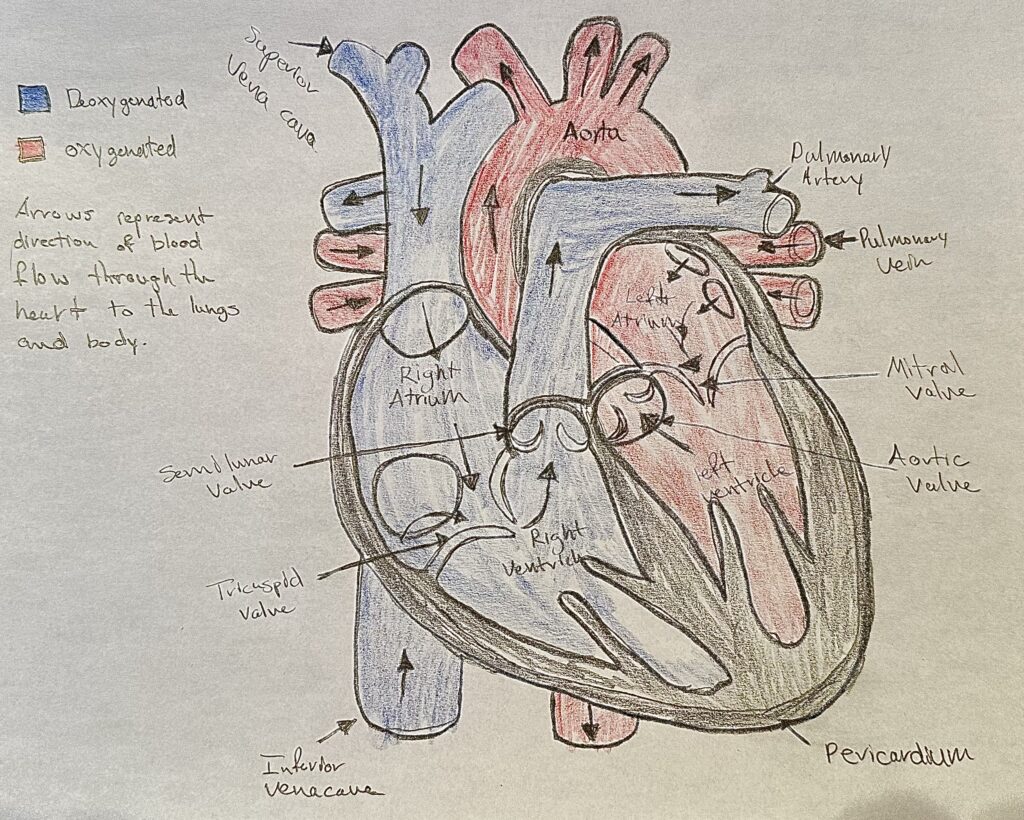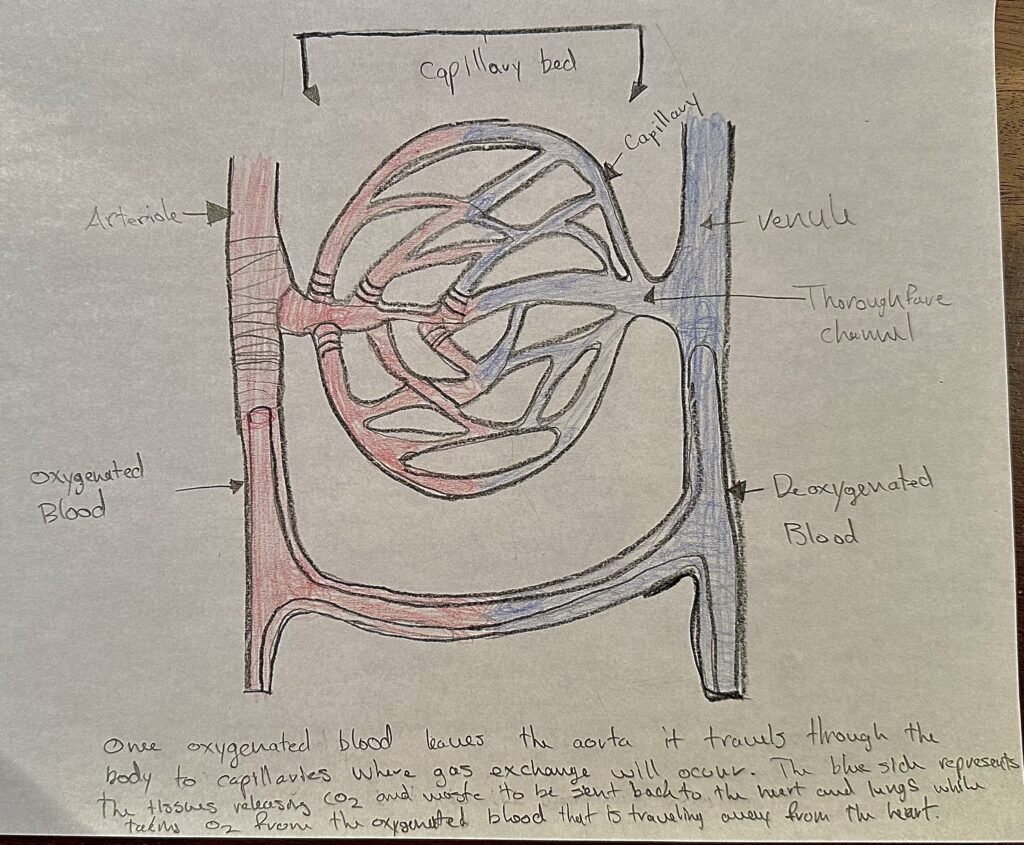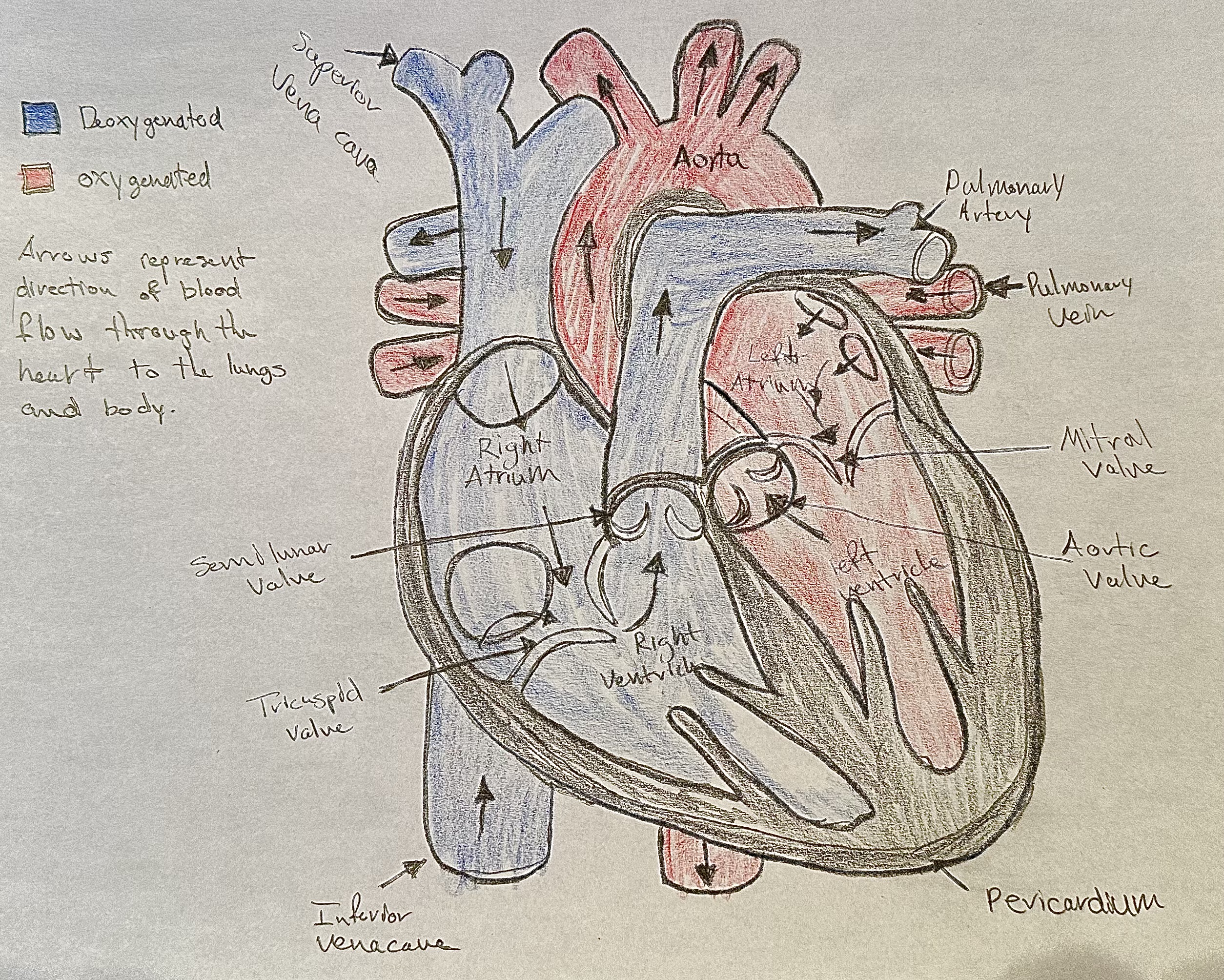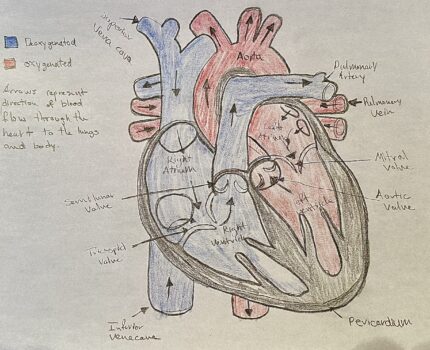


For my STEAM presentation, I will be focusing the course objectives of the cardiovascular and circulatory system and expand on those topics into issues that can occur within the heart. Specifically, I will be expanding on heart valve disease and covering the impacts of this disease on blood flow within the heart and throughout the body. I will be going over the pathway blood takes through the heart and circulatory system, while explaining the structures and functions that are important for maintaining efficient circulation.
Cardiology and cardiovascular health is a topic that has really fascinated me in many different ways. As an athlete it is a major part of my life, seeing how heart disease and other heart complications can impact people really made me want to learn more about the things that can impact this intricate system. I am going to focus in on Heart Valve Disease and the impacts that this can have on blood flow and circulation throughout the body. For my creative section of this project I will be drawing multiple detailed images of the heart, these will include the deoxygenated side and then the oxygenated side of the heart with the valves separating their respective heart chambers. These drawings will detail the path blood takes through the heart, to the lungs and then body. I will include labels and captions in the images that help to explain the function of each part as well as their importance for assisting blood to travel through the heart and get to the designated parts in the body where it is needed.
Throughout this semester in our course work we covered how important heart function, proper blood flow and circulation are in facilitating gas exchange and allowing for our bodies to function efficiently. The circulatory system is an extensive network that connects every part of the body and is made up of arteries, veins, and capillaries, with the heart and its four valves being the major organ and structures that are responsible for pumping blood and maintaining blood pressure throughout this vast network. Blood not only transports oxygen and carbon dioxide but it also carries essential nutrients to other parts of the body at the same time. Bloods role as a connective tissue aids in maintaining tissue health and supporting various physiological processes all over the body, all of which are maintained by proper heart and heart valve function. In the circulatory system arteries carry oxygen-rich blood away from the heart, while veins return deoxygenated blood and waste back to the heart and lungs for removal. Capillaries facilitate the exchange of gasses, nutrients and waste products between the blood and tissues, allowing for proper nourishment and waste removal. Valves play a major role in preventing blood from flowing backward in this system, opening and closing in response to blood pressure differentials and heart contractions.
There are several different types of heart disease that can impact humans with each one exhibiting its own set of symptoms and possible treatments. For some, a simple life style change can resolve the issues, but for others surgery is a necessary step that is needed to correct the issues and restore proper function( WebMD, n.d). Valvular heart disease can be classified based on how it developed, acquired meaning through life style choices or congenital meaning that is was present at birth.(Mrsic et al., 2018) “The prevalence of valvular heart disease is estimated at 2.5% in the US population and sharply increases after the age of 65 years owing to the predominance of degenerative etiologies” (Iung & Vahanian, 2011). Heart valve disease is any condition that impacts the general function or structure of the heart’s valves. The heart has four different valves with each valve regulating blood flow in and out of the chambers that they are connected to. The valves of the heart are separated in two groups the atrioventricular valves and the semilunar valves. The atrioventricular valves are the mitral and tricuspid valves, while the semilunar valves are the aortic and pulmonary valves. “The atrioventricular valves separate the atria and the ventricles. These valves are open during diastole, allowing the ventricles to fill. The semilunar valves are open during systole as blood travels from the heart to the systemic and pulmonary circulations”(Mrsic et al., 2018).
There are two major problems that can cause heart valve disease. These two problems are regurgitation and stenosis. Regurgitation is when the affected valve/valves are unable to fully close which allows blood to flow backwards through the valve. Stenosis is when the affected valve/valves become stiff or narrowed which limits the amount of blood that can be moved through the heart, forcing the heart to pump harder to move blood through these valves (Johns Hopkins Medicine, n.d). The most common types of valve disorders are mitral stenosis, mitral regurgitation, aortic stenosis, and aortic regurgitation(UT Southwestern Medical Center, n.d). Understanding these valve disorders and how they occur is essential for being able to recognize their signs and symptoms and then be able to properly diagnose and treat the issues that are occurring.
Heart valve problems and heart valve disease can originate from several different factors. A few of these factors including congenital heart disease which is present from birth, bacterial infections like rheumatic fever or endocarditis. Rheumatic fever is caused by strep throat or scarlet fever that goes untreated. Endocarditis can develop from bacteria that has entered into the blood stream and then affects the heart, this is life threatening if not treated and can lead to severe damage to the heart and valves. There are some other causes such as high blood pressure, coronary artery disease, or the development of valve issues because of a heart attack. All of these factors can lead to the development of heart valve issues and heart valve disease.(WebMD, n.d). There are symptoms that are related to these issues that assist with diagnosis and treatment.
Heart valve disease can range in severity, with many mild to moderate cases often showing no noticeable symptoms. However some common symptoms of heart valve disease that you should look out for are chest pain, palpitations occurring from irregular heartbeats, fatigue, dizziness, swelling in the legs, shortness of breath, and abdominal discomfort which can occur from an enlarged liver and this is generally linked to cases that involve the tricuspid valve. It’s important to note that many of these symptoms can also occur from other medical conditions and that is why you should always consult a doctor for an accurate diagnosis of your symptoms(Johns Hopkins Medicine, n.d). A doctor will begin diagnosis by listening to the heart through a stethoscope, from there if there are unusual sounds they will begin ordering test to be done. The following common tests can be used to help the physician diagnose any heart issues, Electrocardiogram (ECG), Echocardiogram (echo), Transesophageal echocardiogram (TEE), a chest x-ray, and Cardiac catheterization(Johns Hopkins Medicine, n.d). Once these are completed further steps may need to be taken to resolve any issues. Common treatment options are medication or surgery, with surgery including valve repair or valve replacement(Johns Hopkins Medicine, n.d).
Literature Cited
Iung, B., & Vahanian, A. (2011). Epidemiology of valvular heart disease in the adult. Nature Reviews Cardiology, 8, 162–172. https://doi.org/10.1038/nrcardio.2010.202
Johns Hopkins Medicine. (n.d.). Heart valve diseases. Johns Hopkins Medicine. https://www.hopkinsmedicine.org/health/conditions-and-diseases/heart-valve-diseases
Mrsic, Z., Hopkins, S. P., Antevil, J. L., & Mullenix, P. S. (2018). Valvular Heart Disease. Primary Care, 45(1), 81-94. https://doi.org/10.1016/j.pop.2017.10.002
UT Southwestern Medical Center. (n.d.). Heart valve disorders. UT Southwestern Medical Center. Retrieved from https://utswmed.org/conditions-treatments/heart-valve-disorders/#:~:text=Mitral%20valve%20prolapse%3A%20The%20most,t%20open%20and%20close%20properly
WebMD. (n.d.). Heart disease: Types, causes, symptoms. WebMD. Retrieved from https://www.webmd.com/heart-disease/heart-disease-types-causes-symptoms


Tristan’s STEAM project provided an easy and informative read where he proved a deep understanding about the cardiovascular system as he explored heart valve disease. He explained the causes, symptoms, and management through the two major types of heart valve disease, regurgitation, and stenosis.
He explains how regurgitation is when the affected heart valve, or valves, are unable to fully close causing the blood to flow backward through those affected valves. Stenosis is when the valve, or valves that are affected become stiff and/or narrowed which would then limit the blood that can enter and exit the heart. In turn, this would cause the heart to work much harder to move blood through the valves.
The heart valve disease can vary in severity and ranging in symptoms, but ones that anyone should be aware of are chest pain, palpitations occurring from irregular heart rate, fatigue, dizziness, swelling in legs, shortness of breath, and abdominal discomfort which can occur from an enlarged liver. Diagnosis can be made by a doctor who will first listen to your heart by stethoscope. Further testing such as an electrocardiogram (ECG), echocardiogram (echo), transesophageal echocardiogram (TEE), a chest x-ray, and cardiac catheterization help a physician confirm diagnosis.
Tristan’s visual presentation shows oxygenated and deoxygenated blood moving through the heart and the rest of the circulatory system. He shows understanding of how the blood moves through the circulatory system and the lungs for gas exchange.